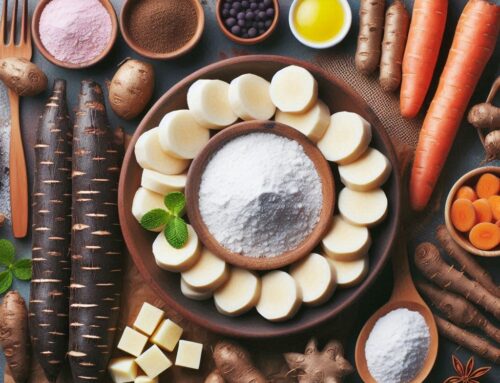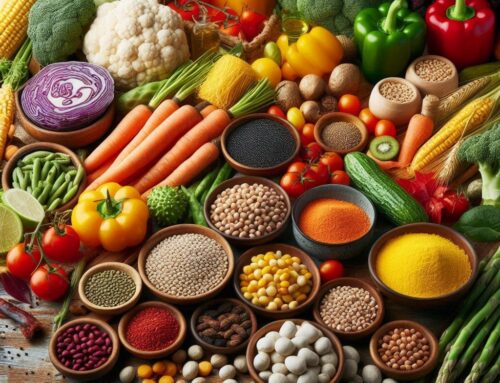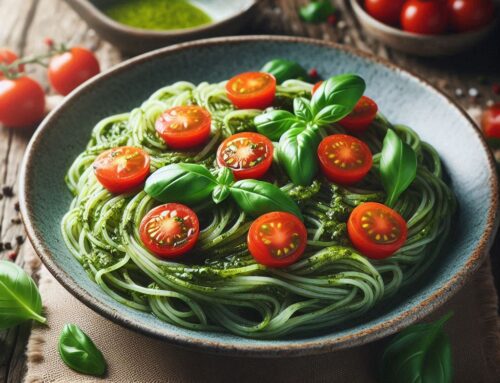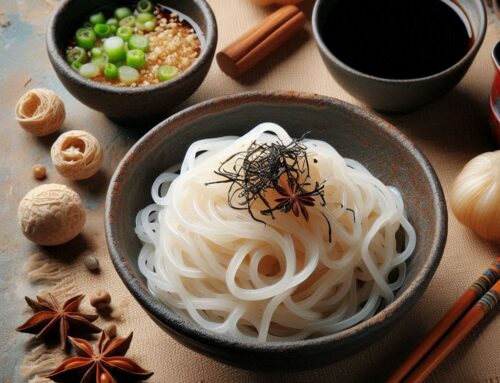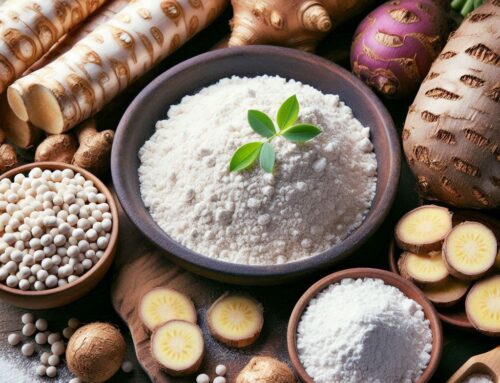
Introduction: Understanding the Versatility of Konjac in the Kitchen
Konjac, a versatile ingredient known for its unique properties and health benefits, is gaining popularity in kitchens around the world. Derived from the root of the konjac plant, this ingredient is particularly valued for its ability to act as a natural thickener. When it comes to konjac cooking, one of its standout features is its use as a healthy thickening agent. Unlike traditional thickeners that may add calories or carbohydrates to your dishes, konjac flour provides a low-calorie alternative that doesn’t compromise on texture or flavor.
The usage of konjac flour extends beyond just thickening; it can also be incorporated into various recipes to enhance nutritional value while maintaining desired consistency. From soups and sauces to gravies and desserts, cooking with konjac allows for creativity without sacrificing health-conscious choices. Its neutral taste ensures that it blends seamlessly into any dish without altering the intended flavors.
For those exploring gluten-free options or looking to reduce carbohydrate intake, konjac presents an exciting opportunity in culinary experimentation. By understanding how this remarkable ingredient can be utilized effectively, home cooks and professional chefs alike can expand their repertoire with innovative dishes that cater to diverse dietary needs.
Mistake #1: Using Too Much Konjac and Its Effects on Texture and Taste
When it comes to using konjac in recipes, achieving the right balance is crucial. One common mistake is using too much konjac, which can significantly affect both the texture and taste of your dish. Konjac’s unique properties make it an excellent thickening agent, but overuse can lead to over-thickening issues that result in an unappealing gel-like consistency.
The key to avoiding these issues lies in understanding konjac proportions. It’s essential to measure konjac accurately to ensure that it enhances rather than overwhelms your culinary creations. A little goes a long way with this ingredient; even a slight excess can alter the taste and turn a delicious dish into something far less palatable.
Konjac taste alteration is another concern when using this ingredient improperly. While konjac itself has a subtle flavor, using too much can impart an unwanted aftertaste that detracts from the intended flavors of the dish. To maintain the integrity of your recipe’s flavor profile, it’s vital to adhere strictly to recommended measurements and adjust as needed based on personal taste preferences.
By being mindful of these factors, you can effectively incorporate konjac into your cooking without compromising on quality or enjoyment.
Mistake #2: Failing to Dissolve Konjac Properly Before Adding It to Dishes
When working with konjac powder, one of the most common mistakes is failing to dissolve it properly before adding it to dishes. This can result in unpleasant clumps that affect the texture and overall quality of your meal. To avoid this issue, it’s essential to understand how to mix konjac correctly.
Start by using a small amount of cold water or another liquid as a base. Gradually sprinkle the konjac powder into the liquid while continuously stirring. This slow incorporation helps prevent clumping by allowing each particle of konjac to be evenly distributed in the liquid. Once fully mixed, you can then add this solution to your dish, ensuring a smooth consistency.
If you find that clumps still form despite careful mixing, try using a whisk or an immersion blender for better results. These tools can help break up any stubborn lumps and ensure that your konjac mixture is perfectly smooth before incorporating it into your recipe.
By taking these steps when dissolving konjac powder, you’ll enhance both the texture and appearance of your dishes, making them more enjoyable for everyone at the table.
Mistake #3: Not Adjusting Cooking Times When Using Konjac as a Thickener
When incorporating konjac as a thickener in your recipes, it’s crucial to adjust cooking times appropriately to achieve the desired consistency. Unlike traditional thickeners, konjac’s unique properties require careful consideration of heat and time. One common mistake is not accounting for the heat impact on konjac consistency, which can lead to unexpected results in your dish.
Konjac flour or powder thickens quickly and can continue to thicken even after being removed from heat. This means that if you’re using it as a substitute for other thickeners like cornstarch or flour, you may need to prolong the cook time slightly. Doing so allows the konjac to fully integrate with other ingredients without becoming overly gelatinous or clumpy.
To avoid this mistake, start by adding small amounts of konjac and gradually increase until you reach the desired thickness. Monitor the mixture closely while adjusting cooking times accordingly; this ensures that you maintain control over texture and flavor balance. By understanding how cooking time adjustments for thickeners affect your recipe, particularly when using konjac, you can create dishes with perfect consistency every time.
Mistake #4: Ignoring the Flavor Profile of Dishes Enhanced by Konhac’s Neutrality
When it comes to culinary creativity, one common mistake is overlooking the flavor profile of dishes when using Konjac as a thickener. Known for its neutral taste, Konjac is an excellent choice for chefs looking to maintain the integrity of their dish’s original flavors while achieving the desired texture. This neutrality allows for seamless flavor balancing with thickeners, ensuring that the essence of each ingredient shines through without interference.
The benefits of using a neutral taste thickener like Konjac are manifold. It provides chefs with the flexibility to enhance dish flavors without altering them. For instance, in delicate soups or sauces where subtlety is key, Konjac can be used to achieve a perfect consistency without overshadowing nuanced notes. Similarly, in desserts where sweetness and other flavor profiles need to be precisely balanced, this neutral thickener ensures that nothing detracts from the intended taste experience.
Ignoring this capability means missing out on an opportunity to elevate your culinary creations. By leveraging Konjac’s unique properties, you can ensure that every dish not only meets textural expectations but also delivers on its full flavor potential.
Mistake #5: Overlooking Dietary Considerations When Incorporating Konjac into Meals
When incorporating konjac into meals, it’s essential to consider its dietary implications to maximize its benefits while avoiding potential pitfalls. Konjac is renowned for being an excellent source of dietary fiber, specifically glucomannan, which can aid in digestion and promote a feeling of fullness. However, caution is advised when introducing this ingredient into your diet, especially for those who are not accustomed to high-fiber foods. A sudden increase in fiber intake can lead to digestive discomfort, so it’s recommended to start with small amounts and gradually increase consumption.
For individuals following a low-carb diet, konjac serves as an ideal ingredient due to its minimal carbohydrate content. It provides the texture and volume that many low-carb dieters seek without adding unnecessary carbs to their meals. Moreover, konjac’s versatility makes it a suitable gluten-free thickening option for soups and sauces. Unlike traditional thickeners that may contain gluten or higher carb content, konjac flour or powder offers a seamless alternative that aligns with both gluten-free and low-carb dietary requirements.
In summary, while konjac presents numerous advantages as a dietary addition—ranging from fiber enrichment to suitability for specific diets—it’s crucial not to overlook these considerations when incorporating it into your meals. Doing so ensures you enjoy the full spectrum of its benefits without unintended side effects.
Conclusion: Mastering the Use of Konhac for Perfectly Thickened Culinary Creations Every Time
In conclusion, mastering the use of konjac as a thickening agent can elevate your culinary creations to new heights. This versatile ingredient, derived from the konjac plant, offers a unique and health-conscious alternative to traditional thickeners. By incorporating konjac into your recipes, you can achieve the perfect consistency without compromising on flavor or nutritional value.
To utilize konjac effectively, it is essential to understand its properties and how it interacts with other ingredients. Konjac’s ability to absorb water and form a gel-like texture makes it ideal for soups, sauces, and desserts that require a thicker consistency. When using konjac powder or flour, remember to add it gradually and whisk continuously to avoid clumping.
Additionally, experimenting with different quantities will help you determine the right balance for your desired thickness. Whether you’re creating a creamy soup or a luscious sauce, starting with small increments allows for better control over the final result.
With practice and patience, you’ll soon find that konjac becomes an indispensable tool in your kitchen arsenal. Its benefits extend beyond just thickening; it’s low in calories and high in fiber content make it an excellent choice for health-conscious cooks looking to enhance their dishes without adding extra calories.
Embrace this innovative ingredient as part of your culinary repertoire—mastering its use will ensure perfectly thickened creations every time while offering endless possibilities for experimentation in both taste and texture!
💡 Tip: To write SEO friendly long-form content, select each section heading along with keywords and use the “Paragraph” option from the floating menu. More descriptive the headings with keywords, the better. Learn more →


